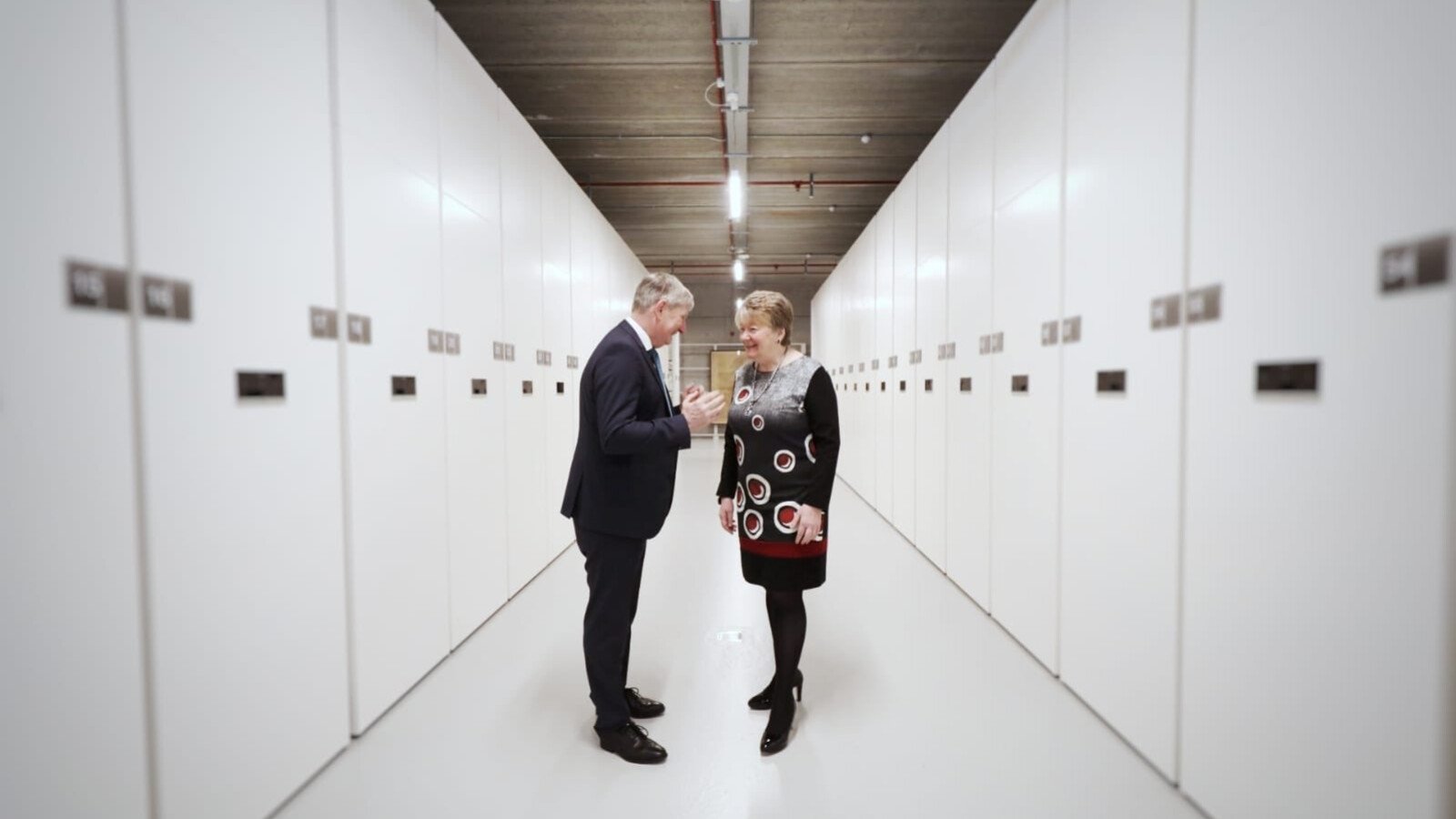-
Applications
-
Product families
-
About Bruynzeel
-
Highlights
Content
- The storage area
- What do you store in your archive
- Analyze logistics
- Optimize storage capacity
- Safety factors
- Accessoires & LED lighting
- Accessibility
2. What Do You Store in Your Archive?
To create the most efficient storage facility, you need to identify your collection. What are you storing? Is it mainly a traditional paper storage or do you need to store items as well? Are there any items that need to be stored flat or in boxes? Are there any special requirements?
Create an Overview
To ensure that you can accommodate current and anticipated storage needs, you’ll need to know what you will be storing. Although time is consuming, detailed cataloguing is worthwhile. If you do not have time or resources to catalogue everything in detail, set time aside to make an item, file or volume list. This gives you an overview of the contents of the collection.
It allows you to:
• make a scan of volume
• make a scan of sizes
• make a scan of any special storage need because of size, weight or special requirements.
Special Requirements
It is important to know how you need to store your items. For example, do they need to be stored flat or in boxes? Such information contributes to theselection of the proper storage system and optimal storage condition for your items. What can help:
• Compile a list of all the materials that need to be stored
• List how the materials need to be stored (in archive boxes, flat, in hanging files, plastic boxes, etcetera).
• List sizes and weight.
• Does (a part of) the collection have special requirements (e.g. dark storage, easy access)
• Is there a need for climate control?
3. Analyze Logistics
When you know the size of your storage space and have identified your storage needs, it is time to think about the logistics, your workflow and the picking frequency of your items.
Analysis
To create an efficient storage area, it is important to analyze the nature of your workflow. Analysis is critical in ensuring the workflow continues to improve the efficiency after redesigning your storage area. An efficient storage and thus an efficient workflow has a lot of additional benefits such as shorter lead times for your personell.mYou can analyze the workflow with them following questions:
• Is there something in your archive that needs to be accessed frequently?
• How many people will work in or use the archive at the same time?
• How many times per day do you need to access to the material?
4. Storage Capacity Optimization
Once you have mapped the storage space, identified what need to be stored and analyzed the picking frequency and workflows, it is time to check how you can optimize the storage capacity. Create an overview Make sure that the storage space you are going to use is used up to the last square feet. By doing so, the storage capacity can be maximized. It is important not to lose sight of the workflow and accessibility. Various cabinets or racks can be selected for archive storage. The available space, the nature of the objects and their storage conditions and workflow must be taken into account when choosing your storage system. There are several storage systems on the market which you can choose from.
Static Racks
Static shelving is a good choice for an archive that is intensively used by a number of different people. Archive material is readily available to all users via permanent aisles, avoiding bottlenecks in the storage room.
High Density Mobile Shelving
High density mobile shelving makes the best use of the available space by using only a single aisle. The shelving can be moved individually or in multiples, where necessary. By choosing a high density mobile shelving system you can, depending on the situation, increase the storage capacity to more than 200% compared to static shelving.
Two-tier mobile shelving
If there is sufficient height in the storage area, a two-tier storage system can be interesting. A two-tier mobile shelving system can increase the storage capacity by 400% compared to regular static shelving. By choosing the right storage system, every cubic inch of an archive room can be used efficiently while all archived items remain at your fingertips.
- Water; As a guideline, pipe work should never run through a storage area because of the damage it can cause.
- Moisture, temperature: To avoid degradation of your stored items, it is important for the archive to be stored in a cool and quite dry room and not exceed ± 2 ° C in temperature variation. With a humidity above 65%, mold can easily spread through your collections.
- Fire: The storage area should be as fire resistant as possible, think of using fire resistant doors and windows. There are even options to make walls, floors and ceilings fire-resistant as well as fire park solutions, where you connect your archive to the fire alarm of the building.
- Light Pollution: Archives should have minimum exposure to sunlight and artificial light due to UV or infrared radiation. LED Lighting doesn’t release any UV or infrared radiation and can thereby extend the life of the collections compared to halogen light sources.
- Emissions: Material such as wood give off acetic acid, which cause archives to deteriorate faster. Galvanized material inflict a serious burden on the environment in both the production and recycling process . Zinc white gives black spots and has an uneven surface, and should never be used when storing books, as it will damage book covers. The best option are open metal shelves, which also allow circulation of air and allow easy inspection and cleaning.
- Unauthorized access: To avoid unauthorized access or theft it is possible to add security features to your storage systems. Mobile shelving can be equipped with many security features, including but not limited to break-in protection, RFID and PIN code to enter specific aisles and lockingm mechanisms.
A list of questions related to safety:
• Are there any water pipes (plumbing, central heating) that run through the premises?
• Are there any water tank or boilers placed above the storage area?
• Do you need a climate system to regulate temperature & humidity?
• Does the storage area have fire resistant doors and windows?
• If you are considering an electronic high density mobile system, does it connect to the fire alarm?
• Is the storage room exposed to direct sunlight?
• What kind of lighting system is available?
• Are you storing historical, fragile, valuable or confidential items or documents? Bear in mind the material that you use for storing these items.
• Are there special safety requirements for the items that are stored?
• Are there any access limitations or restrictions?
Accessories & LED Lighting
Keep your archive uncluttered:
Storage labels and tags
With storage labels and tags it will make it easier to identify the content of a particular aisle, bay or shelf.
Pull-out shelves
Pull-out shelves can be used as a writing desk, work table or temporary storage of smaller goods. With a pull-out frame you can store documents in several types of suspension pocket files, which are accessed from above.
Drawers
Drawers are a great solution for flexible, accessible and safe storage of
collections. Whether it is CDs, DVDs or valuable objects, there is an appropriate drawer system for every requirement.
Dividers
With the help of dividers you can divide the shelf into a number of compartments.
Book support
Sliding book support helps to keep your books or documents upright and locked in any position. Compartments clamps or book ends keep the books, binders or folders upright.
Archive boxes
To protect against light, dust, pollution, pests and damage, archive boxes are often used.
LED lighting
Light pollution is one safety factor that you should keep in mind. Direct exposure to UV or infrared radiation has direct impact on your collection. Consider using LED lighting as it does not release any UV or infrared radiation and can thereby extend the life of the collections compared to halogen light sources.
Accessibility
Accessibility may be required to enable persons with disabilities to gain access to the archive. As far as the storage area is concerned, it is important that it should be barrier-free and adapted to fulfill the needs of all people equally. Making the archives easily accessible will help people with disabilities to contribute to their full potential. There are several things to consider when choosing a storage system:
• Are the aisles between the racks or cabinets wide enough to move and turn with a wheelchair?
• Are there any obstacles that can be a barrier to disabled people?
• If a mobile storage system is chosen, can a disabled person easily operate the control panel? Accessibility may be required to enable persons with disabilities to gain access to the archive. As far as the storage area is concerned, it is important that it should be barrier-free and adapted to fulfill the needs of all people equally.
• If a mobile storage system is chosen, take a good look at which safety,features there are, so that the safety of,disabled as well as non-disabled users
is guaranteed.


-default.jpg)